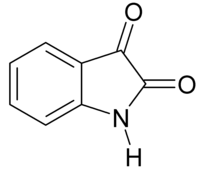
Photo from wikipedia
BACKGROUND The indole framework is considered as one of the privileged structures in the area of medicinal chemistry and drug discovery because compounds containing this framework have shown to possess… Click to show full abstract
BACKGROUND The indole framework is considered as one of the privileged structures in the area of medicinal chemistry and drug discovery because compounds containing this framework have shown to possess remarkable ability to bind with many receptors or proteins with high affinity. It is therefore not surprising that indole nucleus is a frequently found moiety in many bioactive agents or drugs. Indole derivatives have also been explored or studied for their anti-tubercular properties for a long time. The growth inhibition of Mycobacterium tuberculosis (MTB) in vitro and in vivo by the gut microbiota metabolite indole propionic acid (IPA) is one of the recent examples. Notably, tuberculosis (TB) an intractable disease and a major cause of death worldwide have caused an alarming rise in the number of TB cases recently because of two main reasons e.g. a several-fold rise among HIV-infected patients and increased drug resistance by some bacterial strains. Thus identification of new agents or potential drugs against TB is urgently needed. METHODS While the specific pharmacological target or mechanism of action (MOA) for anti-tubercular activities has been reported for many indole derivatives, the MOA is not well defined or known for a number of indole derivatives though they were found to be active against MTB. In the current review article we have focused on both types of indole derivatives that have shown activities against MTB. The indoles with known MOA are further segregated based on this pharmacological target reported or indicated whereas other indoles are classified based on the type of anti-TB properties shown by them. The literature for last 20 years as well as related to up to date knowledge and information was searched on Pubmed, Google Scholar, MEDLINE and various other databases till August 2020. RESULTS A diverse range of functionalized indole derivatives such as indole based alkaloids, simple indoles, fused indoles, amide / peptide derivatives of indole, isatin derivatives etc have been reported to possess anti-tubercular activities. The anti-tubercular activities, in silico studies (if reported) and the chemical syntheses (in most of the cases) of representative indole derivatives are presented briefly in the current article. The papers referenced by this review allow a deep analysis of status of the indole based anti-tubercular agents explored over the past two decades. CONCLUSION This review aims at stimulating renewed interest and effort in the discovery and development of new indole-based agents or potential drugs for the treatment of TB. The emergences of modern methods especially that based on transition metal catalysed reactions have opened up tremendous opportunities in the area of indole synthesis. The desired goal would be to have utilized these modern methodologies for the identification of potent and promising agents to fight against MTB.
Journal Title: Current medicinal chemistry
Year Published: 2020
Link to full text (if available)
Share on Social Media: Sign Up to like & get
recommendations!